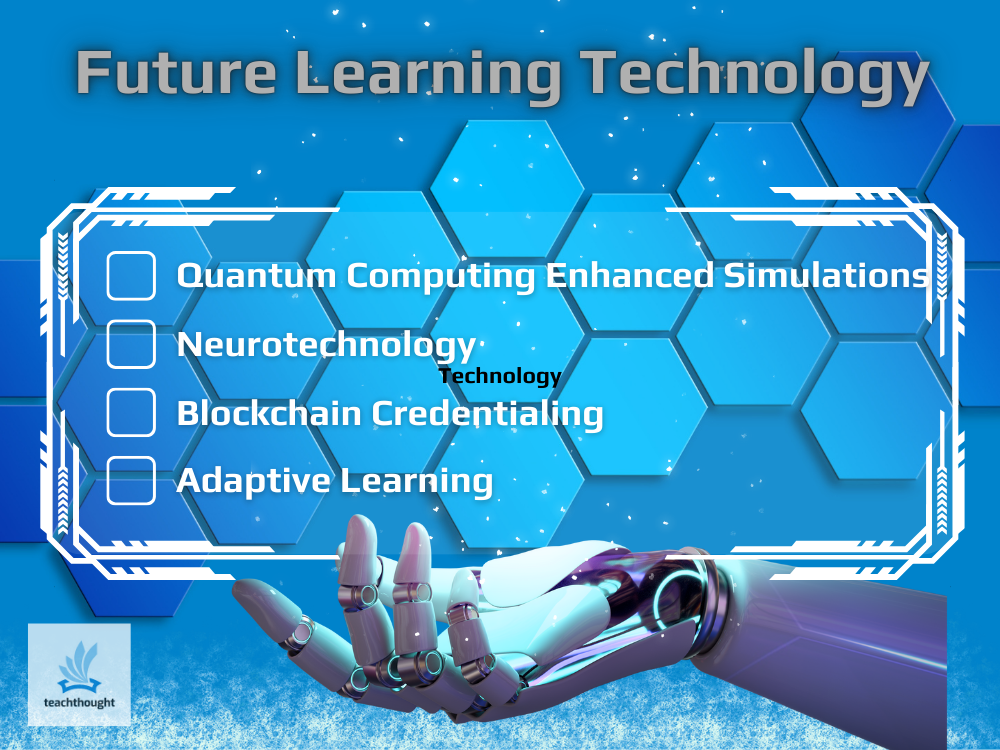by TeachThought Staff
In ‘Shifts For The Classroom of the Future,’ Terrell Heick said, “It’s challenging enough to manage a traditional learning environment where the curriculum is handed to you, and meetings are set, and you’re simply there to manage; adding more ingredients to the mix seems like asking for trouble.
But the truth is, it’s becoming increasingly difficult to educate children in the face of such radical technological and pedagogical progression.”
Compared to the tools we have today, advanced learning technology is beyond the consideration and reach of most practicing teachers.
And we are at least a decade away from most of these if not more.

Certainly, there will more future learning technologies–many we can’t see or even begin to suspect. It may also be the case that none of these technologies are ever realized.
As always, anything that tries to predict technology 25 years from now is highly speculative and likely inaccurate.
However, it may be useful to try to imagine.
See also How To Teach Artificial Intelligence Without Technology
1. Artificial Intelligence Tutors
Artificial Intelligence (AI) tutors will provide personalized learning experiences for each student, adapting to their learning styles and need in real-time. These AI systems will offer instant feedback, identify areas where students struggle, and tailor lessons accordingly.
How And What It Could Change
AI tutors could transform your classroom by ensuring each student receives individualized attention and support, making education more effective and accessible.
2. Quantum Computing Enhanced Simulations
Quantum computing will enable highly advanced simulations and modeling that can handle complex; multidimensional data sets far beyond the capability of current computers. In education, students can engage in intricate physics, chemistry, and biology simulations, experimenting and learning in a risk-free, virtual environment.
How And What It Could Change
Quantum computing-enhanced simulations could revolutionize your teaching by offering deeper insights into scientific phenomena and enhancing problem-solving skills through high-fidelity simulations.
3. Neurotechnology Learning Interfaces
Neurotechnology, including brain-computer interfaces, will facilitate direct interaction between students’ brains and educational content. These interfaces will enable students to control devices and access information using their thoughts, creating new ways to learn and interact with technology.
How And What It Could Change
In the far, far future, neurotechnology learning interfaces could change your classroom dynamics by allowing students with physical disabilities to participate more fully and by providing all students with more efficient and intuitive ways to engage with educational material.
4. Blockchain Credentialing
Blockchain technology will securely store and verify educational credentials and achievements. This will provide a transparent and tamper-proof way of tracking students’ progress and certifications, making it easier for students to share their accomplishments with potential employers and institutions.
How And What It Could Change
Blockchain credentialing could streamline the process of credential verification, reducing fraud and ensuring that your students’ achievements are accurately recognized.
5. Biometric Feedback Systems
Biometric feedback systems will monitor students’ physical and emotional states, providing real-time data to help you understand their engagement and well-being. This technology can detect signs of stress, fatigue, or distraction, allowing for timely interventions to improve learning conditions.
How And What It Could Change
Biometric feedback systems could create a more responsive educational environment where your teaching strategies are adapted based on students’ range of immediate needs.
6. Adaptive Learning Platforms
Adaptive learning platforms will use data analytics and machine learning to create customized learning pathways for each student. These platforms will adjust the difficulty and type of content based on students’ performance and preferences, ensuring they are constantly challenged but not overwhelmed.
How And What It Could Change
Adaptive learning platforms could make your teaching more efficient by optimizing the pace and style of instruction to suit individual learners, leading to better educational outcomes.
